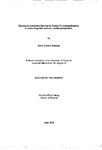Geometric and Extra-Geometric Spatial Conceptualisation: A cross-linguistic and non-verbal perspective
| dc.contributor.author | Crum-Lindqvist, Anne | |
| dc.contributor.other | School of Psychology | en_US |
| dc.date.accessioned | 2014-01-31T09:57:38Z | |
| dc.date.available | 2014-01-31T09:57:38Z | |
| dc.date.issued | 2008 | |
| dc.identifier | N/A | en_US |
| dc.identifier.uri | http://hdl.handle.net/10026.1/2875 | |
| dc.description.abstract |
Almost all past empirical work exploring the Functional Geometric Framework (FGF) proposed by Coventry and Garrod (2004) for spatial language use has been based on a single language - English. Therefore the extent to which the framework applies across languages has not been established. The current thesis investigated whether geometric and extra-geometric factors affect production and comprehension of spatial language across three languages; English, Finnish and Spanish. Eight cross-linguistic appropriateness rating studies identified similarities and differences in the factors that underlie our verbal conceptualisation of space across three classes of spatial relations/terms: 1) topological relations (e.g., in/on), 2) vertical axis projective terms (e.g., above/below), and 3) horizontal axis projective terms (e.g., in front of/behind) and their Finnish and Spanish counterparts. There was support for the FGF crosslinguistically, and many of the results were in line with what has been previously discovered in research on English, although extra-geometric factors, such as conceptual knowledge and dynamic kinematic-routines, were revealed to often have different weightings in different languages. Given the importance of extra-geometric factors across languages, the second part of the thesis asks whether extra-geometric factors also influence (non-linguistic) memory for spatial object relations. This question was addressed by two non-verbal spatial memory experiments which revealed that this was the case in some circumstances. Horizontal shifts in position by a potentially horizontally mobile object were more accurately remembered in specific conditions, i.e. when the located object was positioned along the diagonal axes of the reference object rather than cardinal axes, and when the movement was against the direction of expected movement of the located object. However, location memory for vertical shifts of position, was not affected in such a way by potentially vertically mobile objects in any circumstances. In the closing chapter of the thesis the generalisability of the FGF for crosslinguistic and non-linguistic relations is discussed. | en_US |
| dc.language.iso | en | en_US |
| dc.publisher | University of Plymouth | en_US |
| dc.title | Geometric and Extra-Geometric Spatial Conceptualisation: A cross-linguistic and non-verbal perspective | en_US |
| dc.type | Thesis | |
| plymouth.version | Full version | en_US |
| dc.identifier.doi | http://dx.doi.org/10.24382/3656 | |
| dc.identifier.doi | http://dx.doi.org/10.24382/3656 |
Files in this item
This item appears in the following Collection(s)
-
01 Research Theses Main Collection
Research Theses Main


